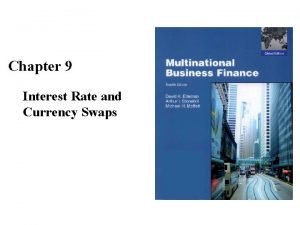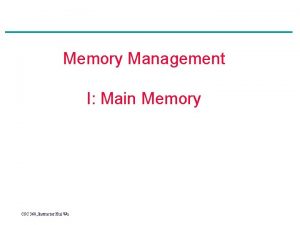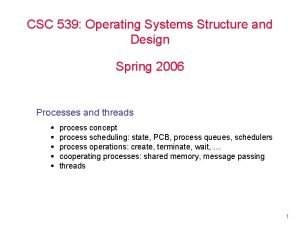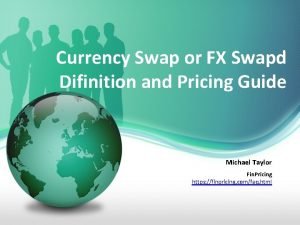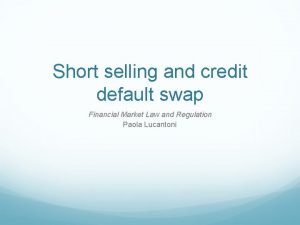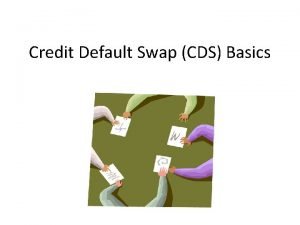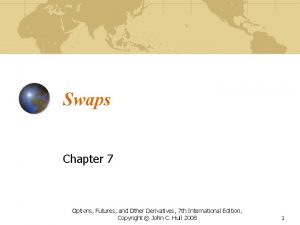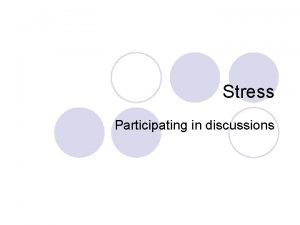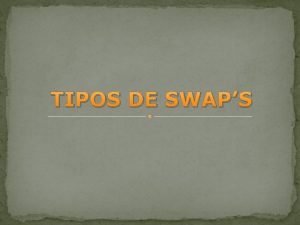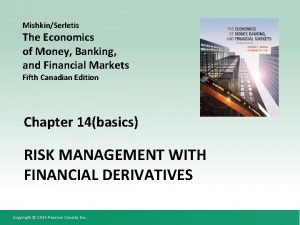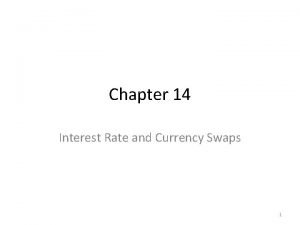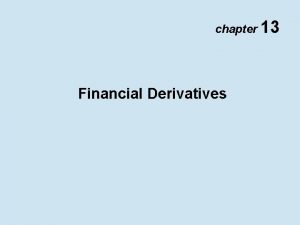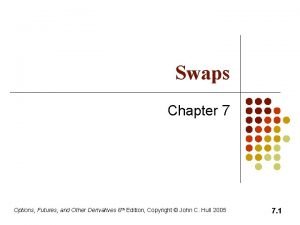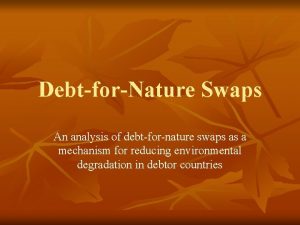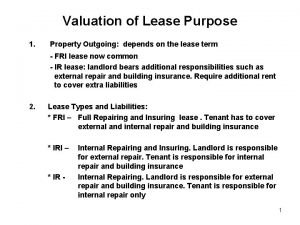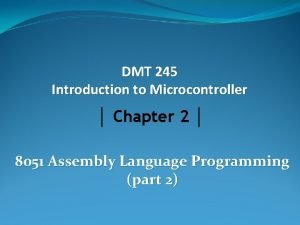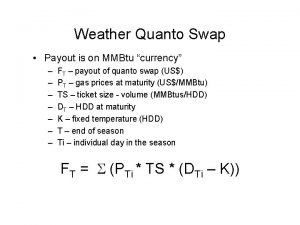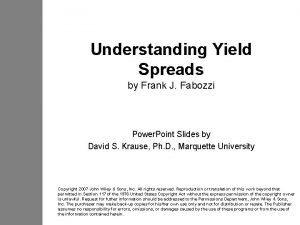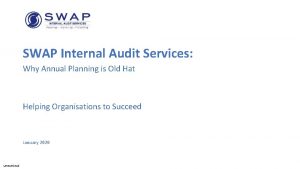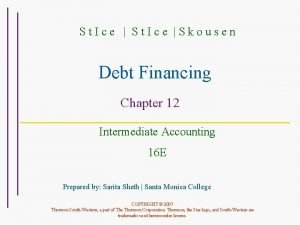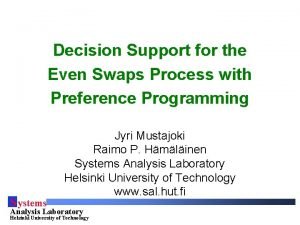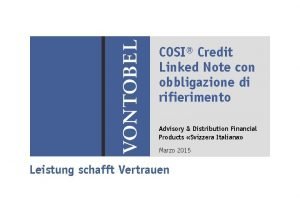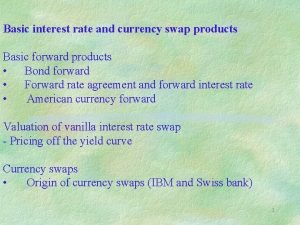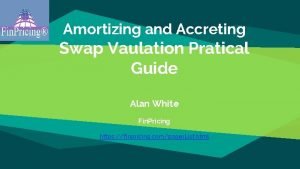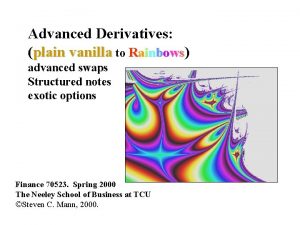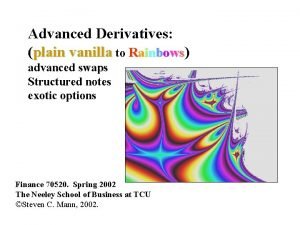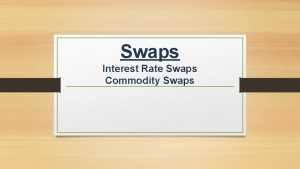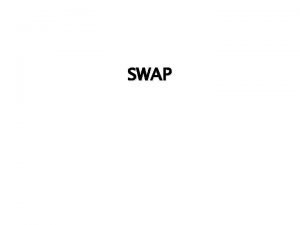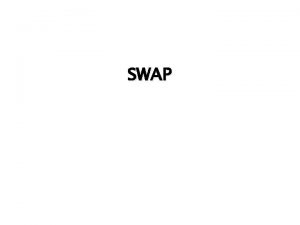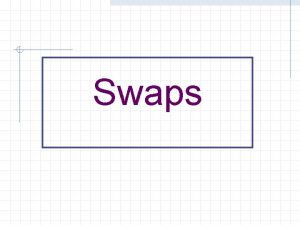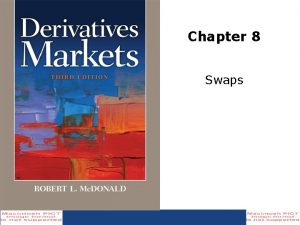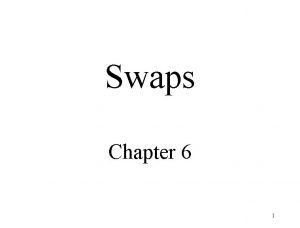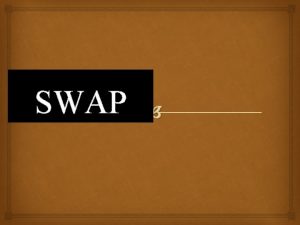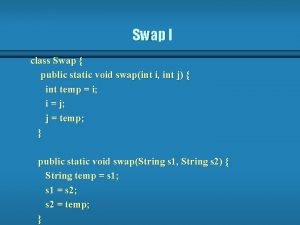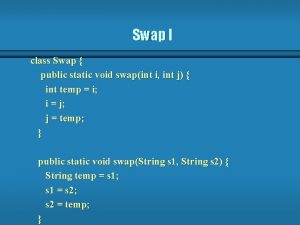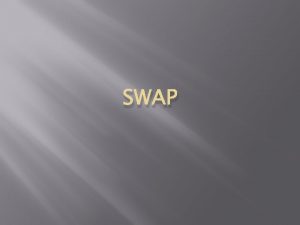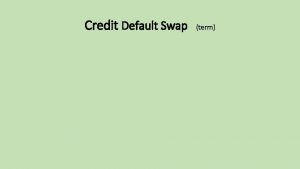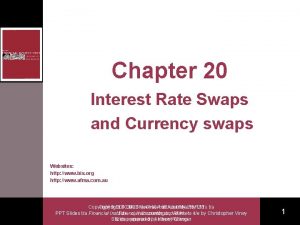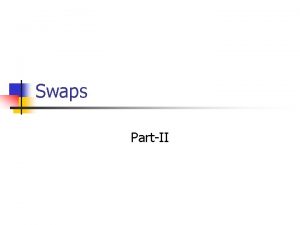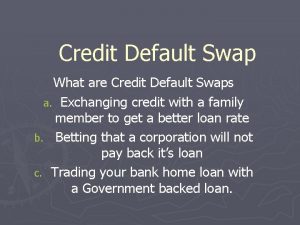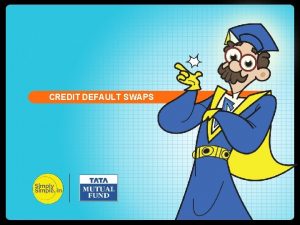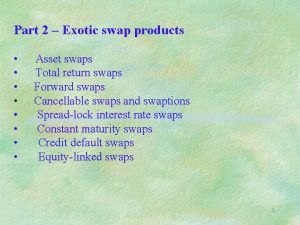SWAPS Types and Valuation SWAPS Definition A swap




































- Slides: 36

SWAPS Types and Valuation

SWAPS Definition A swap is a contract between two parties to deliver one sum of money against another sum of money at periodic intervals. • Obviously, the sums exchanged should be different: – Different amounts (one is a fixed payment, the other one is a variable payment) – Different currencies • The two payments are the legs or sides of the swap. - Usually, one leg is fixed and one leg is floating (a market price).

• The swap terms specify the duration and frequency of payments. Example: Two parties (A & B) enter into a swap agreement. The agreement lasts for 3 years. The payments will be made semi-annually. Every six months, A and B will exchange payments. Leg 1: Fixed A B Leg 2: Variable If a swap is combined with an underlying position, one of the (or both) parties can change the profile of their cash flows (and risk exposure). For example, A can change its cash flows from variable payments to fixed payments.

• Types Popular swaps: - Interest Rate Swap (one leg floats with market interest rates) - Currency Swap (one leg in one currency, other leg in another) - Equity Swap (one leg floats with market equity returns) - Commodity Swap (one leg floats with market commodity prices) - Credit Default Swap (one leg pays fixed, other pay if default occurs) Most common swap: fixed-for-floating interest rate swap. - Payments are based on hypothetical quantities called notionals. - The fixed rate is called the swap coupon. - Usually, only the interest differential needs to be exchanged. • Usually, one of the parties is a Swap Dealer, also called Swap Bank (a large financial institution).

Example: Interest Rate Swap (inception date: April) Bank A (fixed-rate payer) buys an 8% swap Notional: USD 100, 000. Swap coupon (Fixed-rate): 8%. Floating-rate: 6 -mo. LIBOR. (April's 6 -mo. LIBOR: 7%) Payment frequency: semiannual (April and October). 8% Bank A Swap Dealer 6 -mo LIBOR Every six months Bank A (fixed-rate payer) pays: USD 100 M x. 08/2 = USD 4 M Every six months Swap Dealer (floating-rate payer) pays: USD 100 M x 6 -mo LIBOR/2

Example: (continuation) First payment exchange is in October. (The floating rate has already been fixed in April: 7%. ) Then, the Swap Dealer pays: => USD 100 M x. 07/2 = USD 3. 5 M Only the net payment is exchanged: Bank A (fixed-rate payer) pays USD 0. 5 M to the SD. Note: In October, the floating rate will be fixed for the second payment (in April of following year). ¶

Market Organization • Most swaps are tailor-made contracts. - Swaps trade in an OTC type environment. - Swap specialists fill the role of broker and/or market maker. - Brokers/market makers are usually large banks. - Prices are quoted with respect to a standard, or generic, swap. • All-in-cost: price of the swap (quoted as the rate the fixed-rate side will pay to the floating-rate side) • It is quoted on a semiannual basis: absolute level ("9% fixed against six-month LIBOR flat") bp spread over the U. S. Treasury yield curve ("the Treasury yield plus 57 bps against six-month LIBOR flat").

"LIBOR flat" = LIBOR is quoted without a premium or discount. • The fixed-rate payer is said to be "long" or to have "bought" the swap. Example: Houseman Bank's indicative swap pricing schedule. Maturity HB Receives Fixed HB Pays Fixed 1 year 1 -yr TN sa + 44 bps 2 -yr TN sa + 39 bps 2 years 2 -yr TN sa + 50 bps 2 -yr TN sa + 45 bps 3 years 3 -yr TN sa + 54 bps 3 -yr TN sa + 48 bps 4 years 4 -yr TN sa + 55 bps 4 -yr TN sa + 49 bps 5 years 5 -yr TN sa + 60 bps 5 -yr TN sa + 53 bps • Consider the 3 -year swap quote: Housemann Bank attempts to sell a 3 - year swap to receive the offered spread of 54 bps and buy it back to pay the bid spread of 48 bps. HB’s profit: 6 bps.

Example: Goyco wants to receive fixed-rate payments rather than pay fixed-rate for 3 years. The current (“on the run”) 3 -yr Treasury Note rate is 6. 53%. Goyco decides to buy a 3 -yr swap from Housemann Bank. Calculation of fixed rate: HB will pay 7. 01% (6. 53+. 48) s. a. ¶ 7. 01% HB Goyco 6 -mo LIBOR Note: LIBOR will be reset at (T-2) for the next 6 -mo period. • Q: Are swaps riskless? A: No! Default risk is always present.

• The Dealer’s Perspective A swap dealer intermediating (making a market in) swaps makes a living out of the spread between the two sides of the swap. Example: Houseman Bank entered into a 3 -year swap with Goyco. 3 -year quote: 3 -yr TN sa + 48 bps & 3 -yr TN sa + 54 bps The on the run 3 -yr Treasury Note rate is 6. 53%. Floating 7. 07% A 7. 01% Goyco HB LIBOR Fixed LIBOR HB finds a counterparty A => HB gets rid of the swap exposure. ¶ Note: The difference between the rate paid by the fixed-rate payer over the rate of the on the run Treasuries with the same maturity as the swap is called the swap spread. In this example, the swap spread is 54 bps. ¶

Dealer’s Risk • Credit Risk This is the major concern for a swap dealer: the risk that a counter party will default on its end of the swap. • Mismatch Risk It is difficult to find a counterparty that wants to borrow the exact amount of money for the exact amount of time. • Sovereign Risk The risk that a country will impose exchange rate restrictions that will interfere with performance on the swap. Warehousing It likely that the swap dealer (SD) cannot find immediately the other side for all swaps. In these cases, the SD enters a swap and then hedges the interest rate risk using interest rate derivatives, while waiting for a counter party to emerge. This practice is referred to as warehousing swaps.

• Market Size Notional amount outstanding (Dec 2014) : USD 425. 2 trillion. - Interest rate swaps: USD 381. 0 trillion (up from USD 262. 5 trillion in June 2006). It represents 60% of the Global OTC Derivatives Market. - Currency swaps: USD 24. 2 trillion (≈ 5%) - Equity-linked contracts (includes forwards): USD 2. 5 trillion - Commodity contracts (includes forwards): USD 1. 3 trillion - CDS market: USD 16. 4 trillion (≈ 4%) - Gross market value: USD 16. 35 trillion

Growth of Interest Rate Swap Market Source: BIS (2011) ¶

Global OTC Derivatives: Amounts Outstanding (BIS, Dec 2014)

Global OTC Derivatives: Amounts Outstanding (BIS, Dec 2014)

Growth of Swap Market: Interest Derivatives (BIS 2013)

Geography of Swap Market: Interest Derivatives (BIS 2013)

Swaps: Why Use Them? • Using Swaps - Manage risks (change profile of cash flows) - Arbitrage (take advantage of price differentials) - Enter new markets (firms can indirectly create new exposures) - Create new instruments (no forward contract exist, a swap completes the market) (1) Change profile of cash flow Goyco’s underlying situation: Fixed payments, but wants floating debt. A fixed-for-floating debt solves Goyco’s problem. Goyco Fixed

Example: Goyco enters into a swap agreement with a Swap Dealer. Terms: Duration: 3 -years. Goyco makes floating payments (indexed by LIBOR) and receives fixed payments from the Swap Dealer. Fixed Swap Dealer Fixed Goyco LIBOR Q: Why would Goyco enter into this swap? A: To change the profile of its cash flow: from fixed to floating. ¶ • Swaps are derivative instruments (derived valued from value of legs!).

(2) Arbitrage: Comparative Advantage A has a comparative advantage in borrowing in USD. B has a comparative advantage in borrowing in GBP. If they borrow according to their comparative advantage and then swap, there will be gains for both parties. Example: Nakatomi, a Japanese company, wants USD debt. There at least two ways to get USD debt: - Issue USD debt - Issue JPY debt and swap it for USD debt. ¶ Q: Why might a Japanese company take the second route? A: It may be a cheaper way of getting USD debt -comparative advantage.

Note: From an economic point of view, there are two motives for entering into swaps: - Risk Sharing (two firms share interest risk through a swap) - Comparative Advantage/Arbitrage Measuring comparative advantage AAA companies routinely have absolute advantage in debt markets over all the other companies, due to their different credit-worthiness. A swap, however, takes advantage of comparative (or relative) advantages. The Quality Spread Differential (QSD) measures comparative advantage - QSD = Difference between the interest rates of debt obligations offered by two parties of different creditworthiness that engage in the swap. - The QSD is the key to a swap. It is what can be shared between the parties.

Example: Comparative Advantage. Nakatomi, a Japanese company, wants to finance a US project in USD. HAL, a US company, wants to finance a Japanese project in JPY. Both companies face the following borrowing terms. USD rate JPY rate HAL 9% 4% Nakatomi 8% 2% Nakatomi is the more credit-worthy of the two companies. HAL pays 1% more to borrow in USD than Nakatomi. HAL pays 2% more to borrow in JPY than Nakatomi. => HAL has a comparative advantage in the USD rate market. The QSD is 1% (different than zero!). If they borrow according to their comparative advantage and then swap, there will be gains for both parties.

A Swap Dealer proposes the following swap: - Nakatomi pays 7. 6% in USD and receives 2% in JPY - HAL pays 3% in JPY and receives 9% in USD The swap combine with the domestic borrowing produces: Nakatomi’s cost of borrowing: 2% in JPY - 2% in JPY + 7. 6% in USD HAL’s cost of borrowing: 9% in USD - 9% in USD + 3. 6% in JPY 2% JPY 3. 6% USD 9% Nakatomi USD 7. 6% HAL SD USD 9% Note: The Quality Spread Differential (QSD) is not usually divided equally. In general, the company with the worse credit gets the smaller share of the QSD to compensate the SD for a higher credit risk. ¶

Why the Growth of Swap Markets? • Swap contracts have many similarities with futures contracts. - Trade-off: customization vs. liquidity. Futures markets offer a high degree of liquidity, but contracts are more standardized. Swaps offer additional flexibility since they are tailormade. - Settlement is in cash. There is no need to take physical delivery to participate in the market.

Interest Rate Swaps • Most common swap: fixed-for-floating (plain vanilla swap) - Used to change profile of cash flows (a firm can go from paying floating debt to paying fixed debt). - Used to lower debt costs. • Basis swap: floating-for-floating (basis swaps) - Floating rates should be different, say 1 -mo Euribor vs. 3 -mo Euribor or USD LIBOR vs. US T-bill. - Floating-for-floating currency swaps (also called cross currency basis swaps) are especial cases of interest rate basis swaps. • Interest rates swaps have very low bid-ask spreads, lower than corporate bonds and, sometimes, government bonds.

Example: Plain Vanilla Swap Underlying situation for Ardiles Co: - USD 70 M floating debt at 6 -mo LIBOR+1%. - Ardiles Co. wants to change to fixed-rate USD debt. - Currently, fixed-rate debt trades at 9. 2% (s. a. ). A Swap Dealer (Bertoni Bank) offers 8% (s. a) against 6 -mo LIBOR. Terms: - Notional amount: USD 70 M - Frequency: semi-annual - Swap term or tenor (Duration): 4 -years Ardiles Co. and the Swap Dealer will only exchange the net payment (difference between the two legs of the swap: Ardiles pays SD if 6 -mo LIBOR < 8%). The notional principals, obviously, will not be exchanged at the end of the swap (year 4).

Example (continuation): - Ardiles pays 8% (s. a. ) against 6 -mo LIBOR. Ardiles Co. reduces its cost of borrowing to: (6 -mo LIBOR + 1%) + 8% - 6 -mo LIBOR = 9% (s. a. ) (less than 9. 2%) 8% (s. a. ) Ardiles Co. 6 -mo LIBOR/2 Bertoni Bank (Swap Dealer) 6 -mo LIBOR/2 + 1% (s. a. ) Bond holders Now, Ardiles has eliminated floating rate (6 -mo LIBOR) exposures. ¶

• Day Count Convention In the previous examples we have ignored the day count conventions on the short term rates. For example, the floating payment refers to a money market rate, the 6 mo LIBOR, which is quoted on an Actual/360 basis. Suppose 6 -mo LIBOR was fixed at 7%, the notional principal is USD 100 M and assume there are 183 days between payments. Then, the actual payment should be USD 100 M x (0. 07) x (183/360) = USD 3. 5583 M. The fixed side must also be adjusted and as a result the payments may not be equal on each payment date. Note: If the fixed rate is based on a different instrument, say a T-bond, then a different day count should be used for the fixed-rate side. In the Tbond case, it will be based on Actual/Actual.

Swap Curve Ardiles will observe the SD’s indicative swap pricing schedule. The set of swap rates at different maturiries is called the swap curve. It is the equivalente of the yield curve. • As we will see later, the swap curve will be consistent with the interest rate curve implied by the Eurodollar futures contract, which is used to hedge interest rate swaps that cannot be matched. • It is easy to construct for the usual maturities –i. e. , 1 -mo, 3 -mo, 6 -mo, etc. - where there is liquid Eurodollar futures contracts and/or other similar market instruments (FRAs). Interpolation techniques (linear, cubic spline, etc. ) are used to complete the curve.

Swap Spreads Swap spread: Interest rate paid by fixed-rate payer – Interest rate on the run treasury (with same maturity). Example: A pays the SD 7. 07%, while the respective (3 -year) on the run treausry rate is 6. 53%, then the 3 -year swap spread is 54 bps. ¶ We expect to observe positive swap spreads since a negative spread, in theory, signals that banks are viewed as safer than the government. During the 2008 -2009 Financial Crisis, swap rates declined to the level of on the run Treasuries (the swap spread was negative for the 30 -yr maturity). This negative swap spread was considered an aberration (average swap spread 1997 -2007 was 60 bps). But, in September 2015, we observed a similar movement.

But, in September 2015, a similar situation occurred. What is going on? - Regulations: Less market-making by banks, providing less liquidity. - China’s surprise devaluation: PBOC sold U. S. treasuries to stabilize the CNY. Then, dealer’s holdings of US government debt increase, driving repo-rates, which is used to price Treasuries. - Heavy issuing of debt: Companies are in a hurry to lock low rates (usually, they swap the debt from fixed to floating, which causes the swap spreads to tighten).

• Swap spreads are used as an indicator of a country’s credit conditions.

• Valuation of an Interest Rate Swap Assume no possibility of default. (Credit risk zero!, but can use CDS to deal with this risk. ) • An interest rate swap can be valued: - As a long position in one bond a short position in another bond - As a portfolio of forward contracts. Define: V: Value of swap BFixed: NPV of fixed-rate bond underlying the swap BFloat: NPV of floating-rate bond underlying the swap => Value to the fixed-rate payer (Ardiles Co. ) = V = BFloat - BFixed. Note: At inception, V≈ 0. The swap has to be fair.

• The discount rates should reflect the level of risk of the cash flows: An appropriate discount rate is given by the floating-rate underlying the swap agreement. In previous Example, 6 -mo. LIBOR. • Since the discount rate is equal to the floating-rate payment, the value of the floating side payments (BFloat) is equal to par value. • That is, the value of the swap will change according to changes in the value of the coupon (fixed-rate) payments (BFixed) • If the coupon payment is higher than the discount rate => BFixed > BFloat Then, a fixed-rate payer will have a negative swap valuation.

Example: Back to Ardiles’ swap. Suppose the swap has 2 years left. Relevant LIBOR rates: 6 -mo: 6. 00%; 12 -mo: 6. 25%, 18 -mo: 6. 25%, & 24 -mo: 6. 50% Notional amount: USD 70 M Ardiles pays 8% (s. a. ) fixed. Using an actual/360 day count: BFixed = 2. 8/[1 +. 06 x(181/360)] + 2. 8/[1 +. 0625 x(365/360)] + + 2. 8 /[1 +. 0625 x(546/360)] + 72. 8 /[1 +. 065 x(730/360)] = = USD 72, 521, 371. 94 BFloat = 2. 1/[1 +. 06 x(181/360)] + 2. 1875/[1 +. 0625 x(365/360)] + + 2. 1875/[1 +. 0625 x(546/360)] + 72. 275/[1 +. 065 x(730/360)] = = USD 69, 951, 000. 36 (BFloat Q. Why? ) The value of the swap to Ardiles Co. (the fixed-rate payer) is V = USD 69, 951, 000. 36 - USD 72, 521, 371. 94 = USD -2, 570, 368. 38

Example (continuation): The value of the swap to Ardiles Co. (the fixed-rate payer) is V = USD 69, 951, 000. 36 - USD 72, 521, 371. 94 = USD -2, 570, 368. 38 Ardiles has to pay USD 2, 570, 368. 38 to Bertoni Bank -the Swap Dealer- to close the swap. Or viceversa, Bertoni Bank can sell the swap –i. e. , the cash flows for USD 2, 570, 368. 38. ¶ Many banks and investors own Eurobonds with a higher YTM than the current swap rate. An interest rate swap can offer profit opportunities.
 Considering interestrate swaps, the swap rate is
Considering interestrate swaps, the swap rate is Swap out swap in
Swap out swap in Swap out swap in
Swap out swap in Ipc_cont
Ipc_cont Swapd
Swapd Fixed income valuation
Fixed income valuation Selling credit default swaps
Selling credit default swaps Credit default swap ppt
Credit default swap ppt Credit default swap
Credit default swap Swaps
Swaps Banker swaps rat race for bus lane
Banker swaps rat race for bus lane Mercados de forwards y swaps
Mercados de forwards y swaps Swapsmuy
Swapsmuy Advantages of interest rate swaps
Advantages of interest rate swaps Unwinding swaps
Unwinding swaps Forwards vs futures vs options vs swaps
Forwards vs futures vs options vs swaps Swaps
Swaps Debt for nature swap definition
Debt for nature swap definition Outgoing in valuation
Outgoing in valuation Rotate and swap instruction in 8051
Rotate and swap instruction in 8051 Equity valuation definition
Equity valuation definition Quanto swap pricing
Quanto swap pricing Sim swap vodacom number
Sim swap vodacom number Bond swap spread
Bond swap spread Prep for he swap west
Prep for he swap west Swap internal audit services
Swap internal audit services Off balance sheet
Off balance sheet Terri tassie
Terri tassie Java swap dly
Java swap dly Traveling salesman problem
Traveling salesman problem Cancelable swap
Cancelable swap Even swap method
Even swap method Obbligazioni strutturate credit linked
Obbligazioni strutturate credit linked Swapd fee calculator
Swapd fee calculator Accreting swap
Accreting swap Total return swap
Total return swap Total return swap
Total return swap
